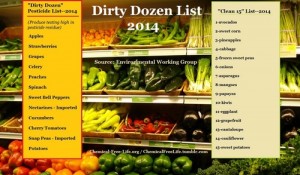Every spring, just in time for summer, the Environmental Working Group, a D.C. non-prof that conducts research on public food safety, publishes  its Dirty Dozen list of produce most tainted with pesticides and other poisons. They’ve trademarked “Dirty Dozen,” which I think is funny and makes me think of Lee Marvin, who strikes me as the kind of man who never ate a single vegetable.
its Dirty Dozen list of produce most tainted with pesticides and other poisons. They’ve trademarked “Dirty Dozen,” which I think is funny and makes me think of Lee Marvin, who strikes me as the kind of man who never ate a single vegetable.
I can see Lee eating an apple though, just ripping into it as a prop while reading somebody the bitterest of riot acts, and that only adds to my disappointment that apples are 2014’s most pesticide-laden fruit. Pesticide poisoned, actually, since the primary pesticide found on 99% of the sampled apples was diphenylamine, a poison banned by the EU and for which the WHO has determined 0.02 parts per million to be the upper limit for safe ingestion by humans.
Our own EPA has designated 0.10 ppm to be the acceptable limit.
After apples, the list includes spinach, peaches, potatoes, and strawberries. It also includes grapes, some of which contained fifteen pesticides per individual grape. Dammit. I love grapes; and the grapes at farmers markets are always so expensive.
The EWG also includes, however, a Clean Fifteen (not trademarked!) to keep our spirits buoyed in the produce aisle. The list includes asparagus, sweet corn, and cauliflower. Only 1% of the avocados sampled carried any detectable trace of pesticides, and 89% of pineapples were pesticide-free.
Notably, the EWG makes this list because the EPA—despite being mandated to provide this kind of information by the Food Quality Protection Law of 1996—simply refuses to do so.

